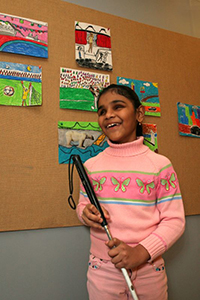Helping Your Child Who Is Blind or Low Vision Get Oriented to a New School Building

By Scott Truax
Starting a new school year is always both exciting and nerve-racking. When a child who is blind or low vision goes to a school building for the first time, it is important that they become very familiar with it to lessen that feeling of being lost that every new student feels.
This process will take some time, and the goal should be to have the basics down before school starts. No one can absorb all the details in one walk-through, so a plan should be put in place to overview, practice, and become independent in stages. Of course, instruction from an orientation and mobility (O&M) instructor is the best option, but families should be prepared to help with the process.
Younger children will not need to be as independent as their older peers but learning the basic locations will make them active participants in moving through the building as opposed to just following along. Work with your O&M instructor to help your child learn the building. If you do not have an instructor available, you should ask for one, but you can also follow the advice below. You will quickly learn that using compass directions is vital for independent travel.
Where to Start?
What are the most important things to learn at a new school? For everyone, the location of their classroom, but a close second would be the nearest bathroom to that room. The cafeteria, playground, and other classrooms can follow for elementary school-aged children. In high school, students need to know the entire building, and emphasis should be placed on a thorough orientation. It is best to build a mental map of the building by slowly adding new information. Here is a sample progression.
- Start with the entrance that will be used each morning.
- Learn the route from that door to the classroom.
- Compass directions will help your child make sense of the environment and will build necessary orientation and mobility (O&M) skills.
- Buildings are a sequence of basically square rooms with long, rectangular hallways. These hallways intersect, and you can almost always hear and feel that intersection.
- Remember that we must always walk on the right side of the hallways to avoid collisions with other students.
- If you choose to walk without a cane, you may “find” things along the way with your shins instead of with your cane.
- Hallways can look the same, so care should be taken to identify good landmarks to be sure of the location.
Landmarks Versus Clues
- Landmarks are permanent; finding them will let you know where you are in the building. The front office often will have a counter that will most likely be a good landmark.
- Clues are things that can help you but will not always be available. For example, the sound of balls bouncing is a great clue that you are close to the gym, but sometimes, the gym will be empty.
- The use of visual landmarks and clues may be appropriate for children with usable vision but take care that the landmarks are clearly perceivable by the student.
Just as cities have major streets, buildings have major doorways and hallways. Use them and name them. For example, the main door hallway, cafeteria hallway, etc.
Once your child knows the classroom location, teach them how to get to the bathroom from the classroom.
Once your child has learned the map of the school, they should be able to go between various destinations without the use of specific routes. A key example would be the ability to get to all of the bathrooms from any location.
(It is an often noted phenomenon that students tend to locate the bathroom quickly but tend to get “lost” on their way back to class. I’m just saying.)
Sample Orientation Script
“From the front door, you will travel south down the hallway (on the right-hand side). The classroom hallway is halfway down, and you will turn right into it and be heading west. Your classroom is two doors down from the water fountain (that is a landmark). Your bathroom is the first door past the water fountain. Bathrooms are often located near the water fountains.”
The foundation of being an independent adult is the ability to learn and navigate in various buildings. These skills are often common sense, and frequently, students with additional disabilities may be challenged in learning academic concepts but good at learning their environment.
Remember that it is best to digest the building in manageable chunks. Very few people can do a walk-through and remember everything. Build upon the knowledge of the building with chances to rehearse. Classes tend to move in groups, but having the chance to practice independence with an adult observing will build the necessary skills. We all get lost from time to time, so learning to problem-solve your location is also important.